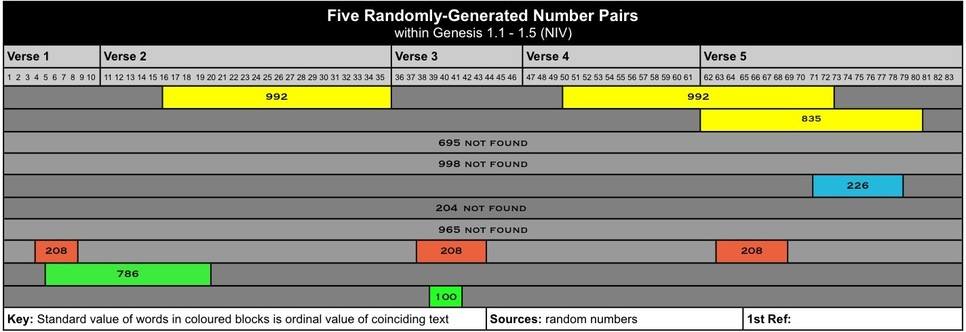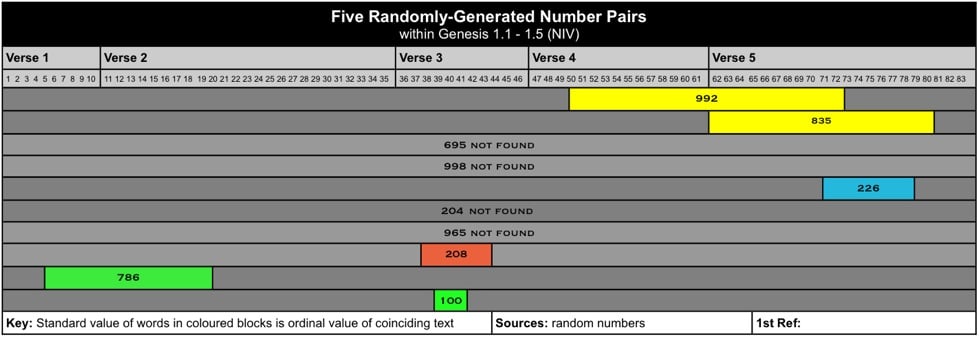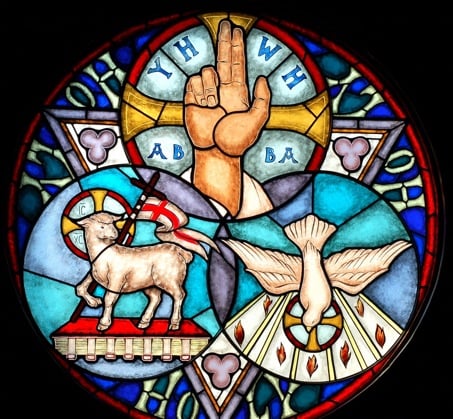The Double Witness
One witness is not enough to convict anyone accused of any crime or offense they may have committed. A matter must be established by the testimony of two or three witnesses. (Deuteronomy 19.15)
The New Bible Code in founded on a unique two-stage encryption-decryption process. Within the text of the NIV Bible numbers have been encrypted under the ordinal value system; these are then converted into words or phrases under the standard value system. The numbers 'planted' in the Garden are no exception. However, in addition, each concept is itself encoded twice. These number-pairs act as a double witness to the reality of the code. They are usually relatively close within the Garden too. [6] As far as I am aware this double-witness phenomenon is another unique feature of the New Bible Code.
Note: In many cases there were multiple instances of one or both numbers in the Garden. This is because different words and phrases can share the same standard value, and these 'extra' numbers take part in other encodings. However, their presence is distracting if shown in the table, so they were left out to put the most closely-aligned pair in the limelight.
Versions and Translation
The Hebrew words and phrases came from the Biblia Hebraica Stuttgartensia, based on the Masoretic Text as preserved in the Leningrad Codex. This is the popular version of the Hebrew Bible. The online version used was the Study Bible. The English words and phrases came from the New International Version (NIV) Bible, 1984 Edition (2001 reprint), in British English. [7]
In the Hebrew Bible, words often come in several forms and spellings, giving a variety of possible numerical values. However, I have found that the first instance of the word or phrase to appear in the Hebrew Bible, along with its equivalent in the NIV, provide the two numbers for encoding, a restriction that defeats any accusations of cherry picking. [8]
Hebrew words can be prefixed with the definite article hey ('the'), but other modifiers (such as 'every', 'this') and conjunctions (such as'and', 'but') were not included. English nouns and noun phrases were treated the same way, although the indefinite article, 'a' (not found in Hebrew), was included if it was part of the translation, which was thought for thought, rather than word for word.
An Example: The Garden of Eden
To make things clear, I've shown below three selected pairs of encoded numbers from the opening words of Genesis. The Hebrew and English names of the objects they represent are also shown. All are from the first biblical references to these concepts, indicated in the lower right-hand box. Each word in the text itself has been replaced by its place value for compactness. Each pair of encodings is colour-coded for clarity.

Looking at the word pair 'ets/trees, these are the ordinal values of the portion of text coincident with the two word blocks. So the ordinal value of words 21 to 24, "the surface of the", is 160, which is the standard value of the Hebrew word 'ets (ayin, tzaddik - giving 70 + 90 = 160). The ordinal value of words 17 to 23, "empty, darkness was over the surface of", is 400, which is the standard value of 'trees' (200 + 90 + 5 + 5 + 100 = 400).
The word-strings shown here are the only examples of these numbers in the Garden. As you can see, each number-pair presents a different scenario.
1. For 'ets/'trees', there is only one instance of each number and the word strings overlap.
2. For B'Gan Eden M'Qedem/'A Garden in the east, in Eden', again there is one instance of each number, but the word strings touch, rather than overlap.
3. In the case of owph/'birds', there are multiple instances of each number. The closest Hebrew/English pair are the first two word strings in verses 1 and 2 (birds/birds overlaps in verse 4 but that is of course English/English, rather than the Hebrew/English double witness).
As I said earlier, for clarity I normally present only the closest matching pair, so the Garden of Eden table would be presented like this:

The reader will hopefully be impressed by the closeness of the pairs in each case. This is over and above the fact that both are found within the first five verses of Genesis, itself a measure of proximity. [9]
Control Experiment 1
As a check on the validity of these encodings, I duplicated the method with randomly-generated numbers. My calculator generates random numbers between 1 and 1000, which isn't too far from the spread of standard values to be expected from single words in English or Hebrew. I calculated them in pairs then looked for those pairs within the Garden. The first number in each pair represents a nominal Hebrew word, the second number represents a nominal English word.

As you can see, only six of the ten numbers can be found in the Garden and only the first and last of the five pairs are complete. This is in line with theoretical expectations, because only around 70% of numbers in the range 1 to 1000 are present, which would mean that only about 50% of randomly-generated pairs in this range would be found. [10] In the first pair (992/835) two of the word strings overlap. The other pair (786/100) is more widely separated. None of the other four pairs are complete and in the case of the second pair neither of the two numbers are found.
Showing only the closest matches once more, the table now looks like this:

Hopefully, it will now be easier to appreciate how unusual it is to consistently find, within this small piece of text, pairs of numbers derived from English and Hebrew words for the same concept.
Control Experiment 2: The Code Signal
Another test for the reality of the code, developed during discussions on the Biblewheel forum, detected what I call the 'code signal', empirical evidence for the reality of the double-witness encodings. The test was based on my claim in The Creation that everything God made during the Creation week is double-witnessed in the Garden and was designed to exclude the possibility of cherry picking and other forms of data manipulation in selecting items from Genesis 1 that might be encrypted in the Garden. The test applied the following selection criteria:
1. Every noun or noun phrase in the Creation narrative was included, so there could be no decision made about what to include and therefore no possibility of cherry picking. Words like 'beginning' and 'food', which are not created things, were therefore tested, so although this method would be expected to detect any code signal we should also expect some dilution from non-encrypted items.
2. The first biblical instance of each noun or noun phrase was chosen every time, again to preempt any possibility of cherry picking.
3. The shortest form of each noun or noun phrase necessary to identify the concept was selected. Adjectives were included if present, since they further defined a concept. So 'wild animals' gives more information than 'animals'. If a noun appeared in different places with and without an adjective, then they were treated as a separate items. So 'animals' and 'wild animals' are both found in Genesis 1 and both were included in the test. Plural forms were included too. However, all determiners, such as articles (eg. 'a', 'the'), demonstratives (eg. 'these', etc), possesives (eg. 'my'), quantifiers (eg 'some') and numbers (eg. 'one'), were excluded. [11]
4. The noun or noun phrase was isolated from the Hebrew Bible first, then the equivalent in the NIV Bible found. This was necessary, since for example three separate words in the Hebrew Bible were all translated as 'creatures' in the NIV Bible. So each Hebrew word was paired with the same word: 'creatures'.
Test Method
1. Every noun or noun phrase within the Creation narrative of the Hebrew Bible (Genesis 1.1 to Genesis 2.3) was isolated, using the stated criteria. The equivalent word or phrase from the NIV Bible was also isolated. This gave 80 word pairs, shown here:
beginning/Reshith 189/911; God/Elohim 71/86; heavens/shamayim 569/390; earth/Aretz 304/291; darkness/choshek 370/328; surface of the deep/paniy tehom 868/591; surface/paniy 505/140; deep/tehom 84/451; spirit of God/ruach Elohim 615/300; spirit/ruach 478/214; waters/mayim 896/90; light/aur 254/207; day/yom 705/56; night/layilah 274/75; evening/ereb 526/272; morning/boqer 306/302; expanse/raqiya 831/380; sky/shamayim 820/390; dry ground/yabbashah 1305/317; ground/yabbashah 511/317; one place/maqowm 'echad 224/199; place/maqowm 109/186; land/aretz 85/291; seas/Yam 206/50; vegetation/deshe' 937/305; seed-bearing plants/eseb zara zera 329/976; plants/eseb 451/372; seed/zera 114/277; trees on the land that bear fruit with seed in it/'ets periy 'asah periy l'miyn asher zeraw bw 'al ha'eretz 3019/2439; trees on the land that bear fruit/'ets periy 'asah periy 1920/1115; trees/'ets 400/160; fruit/periy 605/290; lights/ma'owr 354/641; signs/l'owth 266/831; seasons/mow'edim 416/170; days/yom 805/100; years/shanem 896/400; two great lights/sheni hama'owr hagadowl 1417/1098; greater light/ma'owr hagadol 652/289; lesser light/ma'owr haqatan 584/411; stars/kowkabim 491/98; expanse of the sky/raqiya hashamayim 1930/775; water/mayim 796/90; living creatures/sherets 1299/590; creatures/sherets 794/590; birds/owph 205/156; great creatures of the sea/hatanniym gadol 1482/642; living and moving thing/nephesh hachayah v'haremesht 1400/1403; winged bird/owph kanaph 680/306; living creatures/chay nephesh 1299/453; creatures/nephesh 794/430; livestock/behemah 827/52; creatures that move along the ground/remes 2580/540; creatures/remes 794/540; wild animals/chaiotu h'erets 774/715; animals/chaiotu 231/424; man in our image, in our likeness/'adam b'tselemenu b'demuwthenu 1490/789; likeness/demuwth 319/450; man in our image/'adam b'tselemenu 662/263; man/adam 91/45; image of God/tselem Elohim 199/246; image/tselem 62/160; male and female/zakar neqebah 218/390; male/zakar 76/227; female/neqebah 87/157; face of the whole earth/periy kol h'erets 1201/486; face/periy 15/140; whole earth/kol h'erets 907/346; fish of the sea/dagat h'yam 508/462; fish/dagah 123/407; sea/yam 106/50; birds of the air/'owph shamayim 584/551; air/shamayim 100/390; breath of life/nephesh chayah 422/453; breath/nephesh 306/430; life/chayah 50/23; green plant/yereq 'eseb 508/682; food/oklah 130/56; vast array/tsabam 1583/133; work/mela'kathu 670/497.
2. The standard value of each word pair was calculated, giving the 80 number pairs shown above with the word pairs.
3. Hundreds of sets of 80 randomised number-pairs in the same range as the biblical number-pairs were created. This was done by taking the bibiical list and randomly adding or subtracting numbers between 1 and 50. This method of generating the random numbers was useful here, because the percentage of random hits was critically dependent on the size of the number, with very low and very high numbers achieving less hits than numbers in between.
4. A search for each number was carried out in the Garden (Genesis 1.1 - 1.5).
Results and Discussion
Of the 80 biblical number pairs 58 complete pairs were found in the Garden, a 73% success rate. In hundreds of trials using sets of randomly-generated sets number pairs in the same range as the biblical pairs an average 54% success rate was achieved (this work was done by myself and Richard McGough during discussions with myself on his forum).
Since each pair tested gives a yes/no answer, like flipping a coin, and the expected success rate is close to 50%, the spread of results about the mean will produce a binomial distribution. Using the well-known binomial formula we can therefore calculate how likely we would be to achieve an average 73% success rate or better with 80 number pairs, when the average success rate should be 54%. [12]
For 80 trials and an expected success rate of 54%, the probability of acheiving a 73% success rate or better is 0.00053, or 1 in 1900.
If we increase the number of pairs tested the probability of achieving a success rate higher than the random average decreases. So the true improbability of the phenomenon depends on how much encoded material is present. In The Ark I show further encodings in the Garden, this time related to the Ark of the Testimony. Applying the same selection criteria as before gives a list of 25 items, 20 of which are found in the Garden. These are independent of the list of nouns in Genesis 1 and so can be added to them to give a larger list of 105 items, 78 of which are found in the Garden (74%).
For 105 pairs and an expected success rate of 54%, the probability of acheiving a 74% success rate or better is 0.000015, or 1 in 66000.
The results for the 80 pairs against hundreds of sets of 80 randomised pairs are presented in visual form below, showing the percentage of number-pairs in each set that are found in the Garden. The randomised sets produce a binomial distribution curve, which I have smoothed out. The success rate acheived in the test by the biblical pairs is an outlier of the main group, the diluted but still visible code signal.

As you can see, practically all of the random test results will fall within about fifteen percentage points either side of the mean. The Genesis test results are shown in comparison and they are well beyond the bulk of results to be expected from randomised pairs (roughly 3.5 standard deviations above the mean, for those with some understanding of probability). Further increasing the number of pairs in a set would lead to an even clearer code signal.
The actual encoded material displayed in the next two pages has a statistical significance well beyond four standard deviations. However, these encodings, like the rest of the New Bible Code, are more like works of art than encodings done by rote. Testing requires standardisation of the selection procedure to ensure there is no bias involved, which necessarily means that non-encoded material will be included and the success rate will be below 100%. However, even with dilution and with the likely presence of further as-yet-undiscovered material, the code signal shines through.
The next page in the Garden series is The Creation.
Bill Downie
3/7/17
Last update: 2/11/21
Notes
1. The Genesis Watermark is the name I previously gave the initial few verses, but I now consider both this and the Signature of Christ, the first set of codes I found in that location, to be part of the Garden.
2. This part of the code was even discovered by a double witnessing, namely of myself and Kathryn LeCorre, who was given the revelations that led us to the Garden.
3. Other important numbers are the total ordinal value of 3764 and the total number of words, 83. If we bisect 3764 we obtain 37 and 64, geometrically-related factors of 2368, which is Ihsous Christos (Jesus Christ) in Greek. The geometric relationship between 64 and 37 is this: 64 is the cube of four and 37 is its 2D diagonal projection. In other words, if you observe a cube made of 64 smaller units along its diagonal axis, 37 of those units can be seen. The number of words, 83, is the reduced value of 'the Second Appearance'.
4. I am using the nomenclature of Vernon Jenkins, who first described these special triangular numbers in his own website.
5. There are 31 different combinations of the five verse totals and a pool of 3764 numbers to choose from. 3764 encompases the first 28 'G' triangles. By the binomial formula the odds against this happening by chance are 1 in 604.
6. The ordinal value of the five verses is 3764, therefore any number up to 3764 could theoretically be found in there too. The number of word strings of one or more words in length is 3486, so one might at first glance expect most numbers below 3764 to also be present. However, only 52% are actually are present, as many numbers are found multiple times, which 'pushes out' other possible numbers.
7. This version also contains the entire New Bible Code, of which the Garden is a small part. The US language version also contains the Garden and in fact will contain nearly all of the code, as will earlier editions of the NIV, the latest edition and even other versions: the code has been accumulating since the first Hebrew scribes put pen to parchment). But only the 1984 British-language version has it all.
8. Words and phrases are often found in different forms within the text and this often gives a choice of numbers to test for in the Garden. 'Cherry picking' means selecting individual test results that give the desired answer, and ignoring those that do not, thereby skewing the result in your favour. This was impossible here, because only the first biblical instance of a word or phrase was chosen and its gematria calculated.
9. In my eagerness to display the double-witness phenomenon I rushed it out in March 2017 without fully understanding it. However, after further reflection, including a lengthy discussion with Richard McGough on the Biblewheel forum, I have made some important changes to the page. If anyone has been misled I apologise, but I can see no alternative to presenting the code as I find it, since it will take many decades for a full exegesis.
10. If 70% of numbers in the range 1 to 1000 are present in the Garden we would expect (0.7 x 0.7) x 100, or 49% of randomly-generated pairs to be present. This is before we take account of the clustering phenomenon which also seems to be present. 52% of numbers between 1 and 3764 (the ordinal value of the entire Garden) are found. I am grateful to Richard McGough for his statistical analysis.
11. One could take issue with the selection criteria on other grounds, but it was virtually impossible to find a set of criteria that could be consistently applied. This set of criteria allowed a relatively simple way of extracting nouns and noun phrases from the text and were consistently applied across the board.
12. We are interested in the cumulative probability here, the probability of acheiving 58 hits or better, rather than exactly 58 hits.
